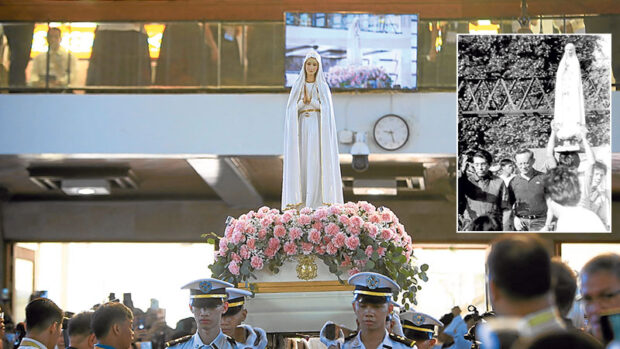Our Lady of Fatima, symbol of Edsa revolution, canonically crowned
FROM ATTIC TO HISTORY’S STAGE | The image of Our Lady of Fatima, which figured prominently in the Edsa People Power Revolution (inset), is canonically crowned in the name of the Pope at its Valenzuela City parish on Sunday, Feb. 25, 2024, as the country marked the 1986 uprising. The image had been stored for decades in the attic of a church in New Jersey before it was brought to the Philippines in 1984. (Photo from the Parish of the National Shrine of Our Lady of Fatima and the Inquirer Archives)
MANILA, Philippines — The national pilgrim image of Our Lady of Fatima, which figured prominently in the 1986 Edsa People Power Revolution, was canonically crowned on Sunday, the same day the country marked the 38th anniversary of the peaceful uprising that ended the Marcos regime.
The widely revered image was carried by then-Defense Minister Juan Ponce Enrile and Armed Forces Vice Chief of Staff Lt. Gen. Fidel Ramos when they addressed the massive crowd on Edsa following their breakaway from Ferdinand Marcos Sr. on Feb. 22, 1986.
During the coronation ceremony, a Holy Mass was celebrated by papal nuncio Archbishop Charles Brown with other archbishops, bishops, and priests at the Parish of the National Shrine of Our Lady of Fatima in Marulas, Valenzuela City, where the Marian image is enshrined.
For Malolos Bishop Dennis Villarojo, the crowning of Our Lady of Fatima was a timely reminder for Filipinos that for four days on Edsa 38 years ago, millions of people took a stand to reclaim their freedom and dignity.
Winds of change
“Edsa may not be the only spark that started it all, but it was certainly the model that revolutionized all revolutions. From then on, revolutions are no longer fought with arms, but with rosaries and flowers,” he said during the homily.
Villarojo cited how the winds of change from Edsa swept across parts of the world to restore democracy: the fall of South Korean military dictator Chun Doo-hwan in 1987, followed by Chile’s Pinochet losing his iron grip on power in 1989. From then on, it was a domino effect, especially in Europe, leading to the tearing down of the Berlin Wall, the lifting of the Iron Curtain and the eventual fall of the Soviet Union.
Edsa did not promise anything but was instead a fulfillment of Mary’s promise of peace after the Filipinos “prayed, made reparations and consecrated [their] hearts,” he said.
“Our Lady of Fatima already gave us the rosary as a weapon for peace. At Edsa, Our Lady fulfilled her promise. She gave us peace because nuns, priests, and the faithful knelt on the hot pavement and prayed the rosary like they had never prayed before. At Edsa, soldiers could not fire at the crowd because the old women praying the rosary in the front lines reminded them of their own mothers and grandmothers praying the rosary at home,” he added.
Noting that nearly four decades had passed without Filipinos appearing to benefit from the bloodless revolution, Villaroja said that Edsa was a “work in progress” and that people should emulate Mary, “who listens, looks beyond self-interest and does whatever the Lord tells her.”
From New Jersey to PH
According to the Catholic Bishops’ Conference of the Philippines, a canonical coronation is a formal ceremony wherein a Marian image is crowned in the name of the Pope.
The Nuestra Señora de Fatima de Valenzuela was among the 50 Marian images blessed by Pope Paul VI on May 13, 1967, in Fatima, Portugal, to mark the golden year of the Fatima apparitions.
The images were later distributed to Catholic nations worldwide, but the one intended for the Philippines went unclaimed. It ended up in the attic of a parish church in New Jersey, USA, until it was turned over in 1984 to then Manila Archbishop Jaime Cardinal Sin through Howard Dee, the Philippine ambassador to the Holy See and Malta.
READ: 38th Edsa revolution anniv ‘more meaningful’ amid Cha-cha drive — groups
On Dec. 8, 1984, the image was brought to the country and became the National Pilgrim Image of Our Lady of Fatima during the celebration of the National Marian Year.
It was brought to Edsa on Feb. 23, 1986, in response to Sin’s call for people to provide a human shield to rebel soldiers led by Enrile and Ramos, who welcomed the image and prayed before it.
In 1999, the image was entrusted to the care of the National Shrine of Our Lady of Fatima in Valenzuela City. INQ















